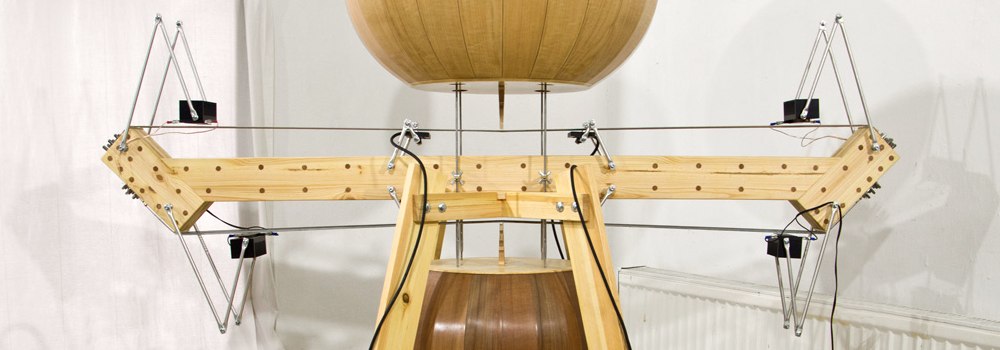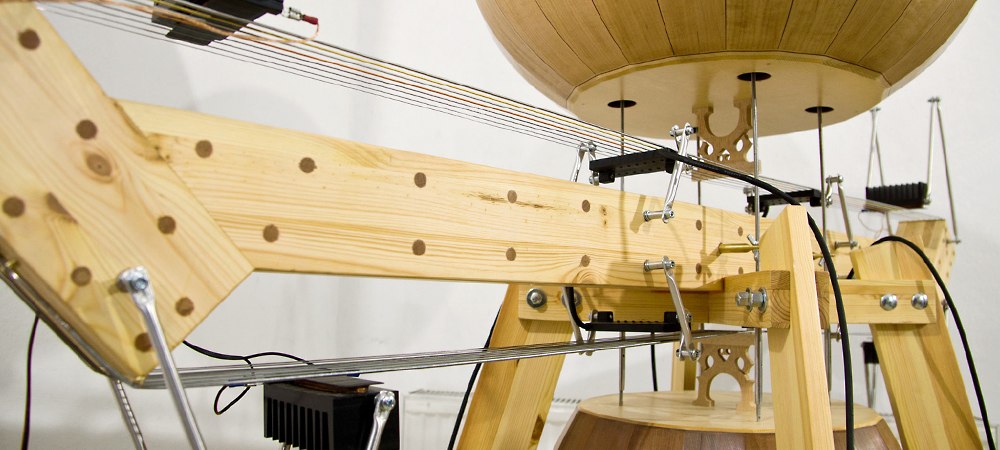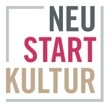H.E.A.R.T. – Harmonic Electro-Acoustic Resonance Transformer 2022
electro-acoustic instrument / sound sculpture
H.E.A.R.T. – Harmonic Electro-Acoustic Resonance Transformer 2022
electro-acoustic instrument / sound sculpture
H.E.A.R.T. (Harmonic Electro-Acoustic Resonance Transformer) is a string-based electro-acoustic instrument. It contains two sets of 8 strings each, two wooden resonance bodies, four dynamic electro-magnets and four electro-magnetic pickups.
H.E.A.R.T. allows any acoustic signal to be sent to the strings via the electro-magnets. This can be analog or digitally created sounds, ambient noise or online content. The strings – tuned to C G G C D G G C (upper set) and C G G C D D G G (lower set) – act as analog musical filters with the string vabration being acoustically amplified by the two resonance bodies.
A 4-channel audio input (via two stereo amplifiers) allows H.E.A.R.T. to be played live by up to four performers, who can send their sound to H.E.A.R.T. via cable and interact with the signal from the pickups. Sounds can also be sent to H.E.A.R.T. via the internet, allowing performers to remotely operate the instrument from anywhere in the world.
H.E.A.R.T. can also operate as stand-alone sound-sculpture with prepared sounds being played over the strings or by connecting the pickups and electro-magnets in a feedback loop, resulting in constant string resonance through self-oscilation.
The idea for H.E.A.R.T was born during the time of public restrictions caused by the Corona Pandemic. The understandable need to move art and culture into the digital space cut off recipients from the irreplaceable live experience.
On the other hand, performers have no control over the reception experience of their listeners and viewers in the online setup . They can only ensure the quality of their performances and their recording media, but not the quality of the transmission or the quality of the end devices used by the recipient.
In the years 2020 to 2022, countless masterfully performed concerts - by major orchestras, among others - were sent as binary information around the world to be played back from the speakers of a phone, tablet or laptop somewhere, leaving not only the live experience but also the sound quality by the wayside.
The question behind the idea for H.E.A.R.T. is whether something like a live experience can be generated even if the performer is not physically present at the performance site. The strategy that H.E.A.R.T. proposes in this context is to create the possibility that the recipient and the instrument are in the same physical space, while the performer plays the instrument via the internet.
Das Projekt wurde aus Mitteln des Förderprogramms NEUSTART KULTUR gefördert.
The project was funded be the NEUSTART KULTUR („restart culture“) programme.




